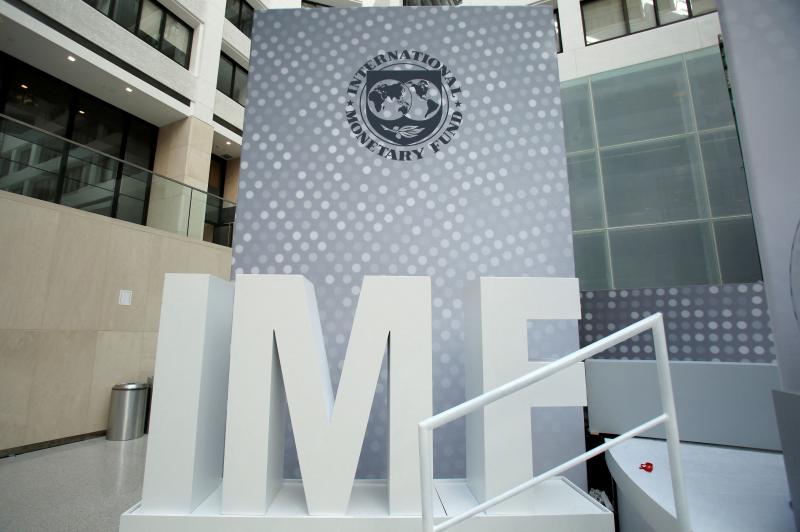The IMF boosted its growth forecast for Asia this year, reflecting a rosier outlook for the region’s two largest economies and flagging a possible upward revision in its outlook for China.
Asia is set to expand 4.5 percent this year from the prior year, 0.3 percentage points higher than the October regional outlook but a slowdown from last year’s 5 percent pace, according to the IMF report on Tuesday.
The IMF raised its forecast for Taiwan’s GDP growth for this year to 3.1 percent, up 0.1 percentage points from its October estimate and the highest among advanced economies in Asia.

Photo: Reuters
The IMF cut its projection for Taiwan's economy next year by 0.1 percentage points to 2.7 percent.
The latest data has taken into account the higher forecast for India published earlier this month and China’s pace, on the back of expectations that government stimulus will boost growth. On China, the IMF said first-quarter growth came in stronger than expected on robust exports and manufacturing demand, which may prompt another upward revision.
“Global disinflation and the prospect of lower central bank interest rates have made a soft landing more likely, hence risks to the near-term outlook are now broadly balanced,” IMF’s Asia and Pacific department director Krishna Srinivasan wrote in a blog post.
China’s central government has ramped up spending this year to support an economy still reeling from a weakened property sector and to propel growth to its target near 5 percent this year. In India, the government ramped up capital spending by a third for this year, the third year in a row.
China’s real GDP is seen expanding 4.6 percent this year from the prior year, and India to rise 6.8 percent this year, the IMF said. Officials left next year's regional outlook unchanged at a 4.3 percent advance.
Several risks remain, the IMF said. Chief among them is a long-term property sector downturn in China, which would weaken demand and prolong deflation. Other challenges include growing fiscal deficits and risks to trade from US-China tensions.
Officials also warned Asian nations of pinning too much on expectations for the US Federal Reserve’s path when deciding their own monetary policy. Indonesia this month unexpectedly raised interest rates to address a currency walloped by a strengthening US dollar. Southeast Asia’s largest economy is among many countries in the region contending with currency depreciation as the prospects of early Fed rate cuts wane.
While following the Fed “could limit exchange rate volatility” but “it risks that central banks would fall behind (or move ahead of) the curve and destabilize inflation expectations,” Srinivasan wrote.
Additional reporting by staff writer

When an apartment comes up for rent in Germany’s big cities, hundreds of prospective tenants often queue down the street to view it, but the acute shortage of affordable housing is getting scant attention ahead of today’s snap general election. “Housing is one of the main problems for people, but nobody talks about it, nobody takes it seriously,” said Andreas Ibel, president of Build Europe, an association representing housing developers. Migration and the sluggish economy top the list of voters’ concerns, but analysts say housing policy fails to break through as returns on investment take time to register, making the

‘SILVER LINING’: Although the news caused TSMC to fall on the local market, an analyst said that as tariffs are not set to go into effect until April, there is still time for negotiations US President Donald Trump on Tuesday said that he would likely impose tariffs on semiconductor, automobile and pharmaceutical imports of about 25 percent, with an announcement coming as soon as April 2 in a move that would represent a dramatic widening of the US leader’s trade war. “I probably will tell you that on April 2, but it’ll be in the neighborhood of 25 percent,” Trump told reporters at his Mar-a-Lago club when asked about his plan for auto tariffs. Asked about similar levies on pharmaceutical drugs and semiconductors, the president said that “it’ll be 25 percent and higher, and it’ll

NOT TO WORRY: Some people are concerned funds might continue moving out of the country, but the central bank said financial account outflows are not unusual in Taiwan Taiwan’s outbound investments hit a new high last year due to investments made by contract chipmaker Taiwan Semiconductor Manufacturing Co (TSMC, 台積電) and other major manufacturers to boost global expansion, the central bank said on Thursday. The net increase in outbound investments last year reached a record US$21.05 billion, while the net increase in outbound investments by Taiwanese residents reached a record US$31.98 billion, central bank data showed. Chen Fei-wen (陳斐紋), deputy director of the central bank’s Department of Economic Research, said the increase was largely due to TSMC’s efforts to expand production in the US and Japan. Investments by Vanguard International

WARNING SHOT: The US president has threatened to impose 25 percent tariffs on all imported vehicles, and similar or higher duties on pharmaceuticals and semiconductors US President Donald Trump on Wednesday suggested that a trade deal with China was “possible” — a key target in the US leader’s tariffs policy. The US in 2020 had already agreed to “a great trade deal with China” and a new deal was “possible,” Trump said. Trump said he expected Chinese President Xi Jinping (習近平) to visit the US, without giving a timeline for his trip. Trump also said that he was talking to China about TikTok, as the US seeks to broker a sale of the popular app owned by Chinese firm ByteDance Ltd (字節跳動). Trump last week said that he had